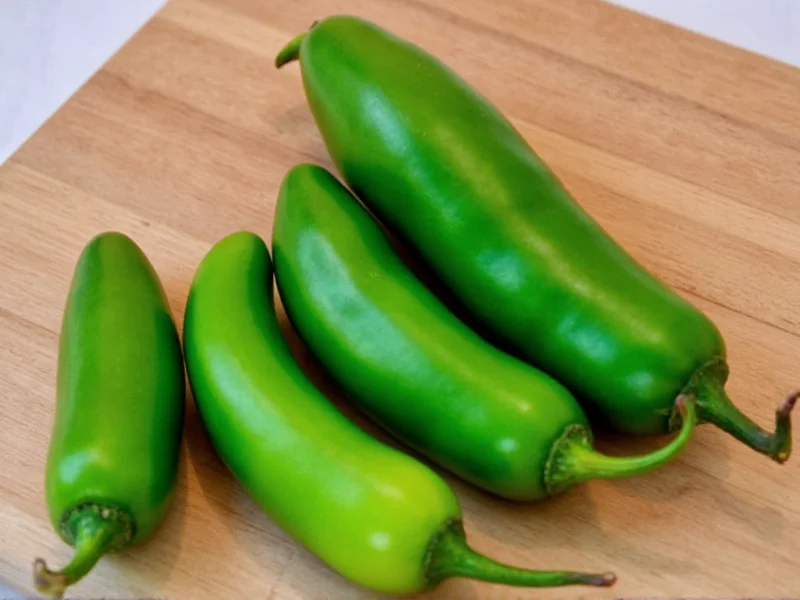When comparing which is spicier serrano or jalapeno, the answer is clear: serrano peppers deliver a noticeably more intense heat experience. Understanding the precise difference between these popular chili peppers matters for home cooks and culinary professionals who need to balance flavors without overwhelming heat.
The Scoville scale provides the definitive measurement for comparing pepper heat. Developed by pharmacist Wilbur Scoville in 1912, this scale measures capsaicin concentration—the compound responsible for chili pepper heat. While both peppers belong to the Capsicum annuum species, their heat profiles differ substantially due to genetic variations and growing conditions.
| Pepper Type | Scoville Heat Units (SHU) | Heat Relative to Jalapeño | Flavor Profile | Common Uses |
|---|---|---|---|---|
| Serrano | 10,000-23,000 | 2-4x hotter | Bright, grassy, slightly floral | Salsas, guacamole, pickled preparations |
| Jalapeño | 2,500-8,000 | Baseline | Grassy, vegetal, sometimes smoky | Stuffed peppers, nachos, poppers, sauces |
Understanding the Heat Difference: Serrano vs Jalapeño
When exploring how much hotter is serrano than jalapeno, the difference becomes apparent through both measurement and experience. The average jalapeño registers around 5,000 SHU, while the typical serrano measures approximately 15,000 SHU—making serranos generally three times hotter. However, this comparison varies because both peppers have wide heat ranges depending on growing conditions, maturity, and specific variety.
Several factors influence the actual heat you'll experience with each pepper:
- Seed and membrane concentration: The white pith and seeds contain most capsaicin—removing these reduces heat significantly in both peppers
- Growing conditions: Stressors like inconsistent watering or nutrient deficiencies increase capsaicin production
- Maturity: Riper peppers (red varieties) often develop more complex flavors while maintaining similar heat levels
- Regional variations: Mexican-grown serranos often pack more heat than those cultivated in milder climates
Practical Cooking Implications
Knowing serrano pepper heat level compared to jalapeno directly impacts recipe execution. When substituting one for the other, consider these practical guidelines:
If your recipe calls for jalapeños but you only have serranos: Use approximately one-third the amount of serranos to achieve similar heat levels. For example, where a recipe specifies one whole jalapeño, use just one-third of a serrano pepper. Always taste as you go, as individual pepper heat can vary dramatically.
Conversely, when substituting jalapeños for serranos: You'll need to increase the quantity, but be aware that you won't fully replicate the serrano's distinctive bright, grassy flavor profile. Two to three jalapeños might approach the heat of one serrano, but the flavor characteristics will differ.
Flavor Profiles Beyond Heat
While heat comparison dominates the serrano vs jalapeno scoville scale discussion, flavor differences significantly impact culinary applications. Serranos deliver a cleaner, brighter heat with grassy, sometimes slightly floral notes that work exceptionally well in fresh salsas and guacamole. Their thinner walls make them less suitable for stuffing but perfect for quick-cooking applications.
Jalapeños offer a more rounded flavor profile—grassy with potential smoky notes, especially when roasted. Their thicker walls make them ideal for stuffing, pickling, or creating poppers. The milder heat allows jalapeños to blend more seamlessly into dishes without dominating other flavors.
When to Choose Each Pepper
Selecting between these peppers depends on your desired outcome:
Choose serranos when:
- You want immediate, upfront heat that dissipates relatively quickly
- Creating fresh salsas where bright pepper flavor enhances rather than overwhelms
- Need a cleaner heat profile without competing flavor elements
- Preparing Mexican dishes authentic to regions where serranos are traditional
Choose jalapeños when:
- You prefer gradual heat that builds and lingers
- Stuffing peppers or creating poppers
- Need a more versatile pepper that works in both mild and hot applications
- Creating dishes where pepper flavor should complement rather than dominate
Handling Hot Peppers Safely
Working with either pepper requires proper handling techniques, especially when dealing with the significantly hotter serranos. Always:
- Wear gloves when handling, particularly when seeding
- Avoid touching your face, especially eyes
- Wash hands thoroughly with soap after handling
- Cut peppers on a dedicated cutting board that won't transfer oils to other foods
Remember that cooking doesn't eliminate capsaicin—it merely distributes it throughout your dish. If you accidentally make a dish too spicy, dairy products (milk, yogurt, sour cream) provide the most effective relief due to casein's ability to break down capsaicin.
Frequently Asked Questions
Can I substitute serrano for jalapeño in recipes?
Yes, but use approximately one-third the amount of serrano to match jalapeño heat levels. For example, replace one jalapeño with one-third of a serrano pepper. Remember that flavor profiles differ—serranos offer brighter, cleaner heat while jalapeños provide more rounded flavor.
Why are my jalapeños sometimes hotter than serranos?
Pepper heat varies significantly based on growing conditions. Stressed plants (from inconsistent watering or nutrient deficiencies) produce hotter peppers. Your particular jalapeños might have experienced more stress than the serranos you're comparing them to, temporarily reversing the typical heat relationship.
Which pepper is better for making hot sauce?
Serranos create brighter, cleaner hot sauces with immediate heat, while jalapeños produce more rounded sauces with gradual heat buildup. For authentic Mexican-style sauces, serranos are traditional. For milder, more versatile sauces that appeal to broader palates, jalapeños work better. Many professional hot sauce makers blend both for complexity.
Do red jalapeños or serranos taste different from green ones?
Yes, ripening changes both heat and flavor. Red jalapeños and serranos are fully mature versions that develop sweeter, fruitier notes while maintaining similar heat levels. Green peppers offer brighter, grassier flavors. The heat difference between red and green versions of the same pepper type is minimal, though some detect slightly increased heat in riper peppers.
How can I reduce the heat of either pepper without losing flavor?
Remove seeds and white membranes (placenta) where most capsaicin concentrates. For jalapeños, leaving some membranes provides moderate heat; for serranos, removing all membranes significantly reduces their intense heat. Roasting peppers can mellow their heat while enhancing sweetness. Adding acid (lime juice, vinegar) or sweetness (honey, sugar) balances heat in finished dishes.











 浙公网安备
33010002000092号
浙公网安备
33010002000092号 浙B2-20120091-4
浙B2-20120091-4